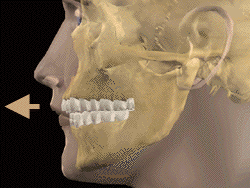

ORTHODONTICS
- Teeth & Face Classifications
- Impacted & Missing Teeth
- Crowding & Spacing of Teeth
- Orthodontic Disorders
- Braces
- Headgear
- Appliances
- Retainers
- Invisalign
Our Orthodontists
Message Form
Teeth and Face Classifications
Classification of Teeth
The classification of bites is broken up into three main categories: Class I, II, and III.
Class I: Class I is a normal relationship between the upper teeth, lower teeth, and jaws or balanced bite.
|
|
|
Class II: Class II is when the lower first molar is posterior (or more towards the back of the mouth) than the upper first molar. In this abnormal relationship, the upper front teeth and jaw project further forward than the lower teeth and jaw. There is a convex appearance in profile with a receding chin and lower lip. Class II problems can be due to insufficient growth of the lower jaw, an overgrowth of the upper jaw, or a combination of the two. In many cases, Class II problems are genetically inherited and can be aggravated by environmental factors such as digit sucking. Class II problems are treated via growth redirection to bring the upper teeth, lower teeth, and jaws into harmony.
|
|
Class III: Class III is when the lower first molar is anterior (or more towards the front of the mouth) than the upper first molar. In this abnormal relationship, the lower teeth and jaw project further forward than the upper teeth and jaws. There is a concave appearance in profile with a prominent chin. Class III problems are usually due to an overgrowth in the lower jaw, undergrowth of the upper jaw or a combination of the two. Like Class II problems, they can be genetically inherited.
|
|
Classificaiton of Face
It is not sufficient to categorize orthodontic malocclusions on the basis of a classification of the teeth alone. The relationship with other craniofacial structures must also be taken into consideration.
Class I
|
|
Class II
|
|
|
Class III
|
|
Home | Patient Information | Home Care | Dental Implants in Jeddah & Medina | Orthodontics in Jeddah & Medina
Dentistry in Jeddah & Medina | Pediatrics in Jeddah & Medina | Fun & Games | Meet Our Dentists | Patient Registration | Referral Form
Contact Us | Disclaimer | Sitemap| Dental Website Design By PBHS © 2009













